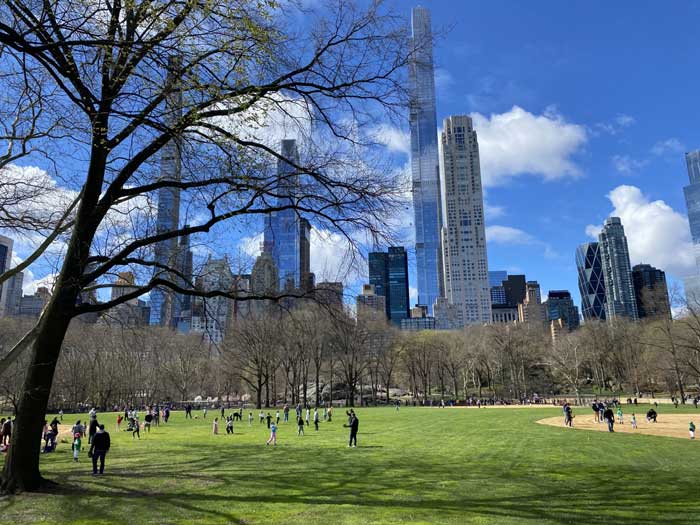Sports field managers have plenty to consider as far as keeping their fields safe and game-ready: deadlines, equipment, employees, budgets, and of course, Mother Nature. But there’s also fans, owners, athletic directors, coaches, administrative staff, and facility and event managers to keep happy, and these different entities don’t always understand the challenges that turf managers contend with to keep their fields in playing shape. Simply put, sports field managers just want some respect, as their work requires a high level of skill and experience.
The Sports Field Management Association (SFMA) has a mission to “advance professionalism in sports field management and safety through education, awareness programs, and industry development.”
Turf Care
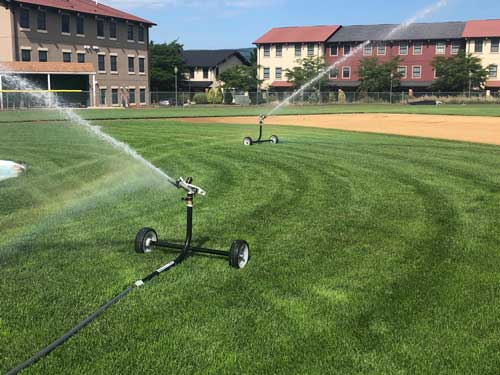
Zack Holm is on the SFMA board of directors as the director of parks & recreation. He’s the turf care manager for the Central Park Conservancy in New York City, which is entrusted by the city with day-to-day care of the iconic space. He previously managed operations at the New York Red Bulls training facility (a professional soccer team), and worked in Minor and Major League Baseball.
Central Park receives 42 million visitors annually, and features 300-plus acres of turfgrass, including 26 baseball/softball fields. “These are all natural fields,” said Holm, “and all 26 infields are fully skinned.”
While these fields are for the
public’s enjoyment, they’re also used by youth and adult leagues, with permitting going through NYC Parks. “We’ll pull a handful of permits ourselves throughout the year to conduct cultural practices such as aerification.”
Generally, “the fields open for play at 11 a.m. Monday through Friday, and 8 a.m. on weekends, April through November. A benefit to these set opening times is giving our team the time to mow when needed and conduct other important cultural practices such as seeding.
“We use two different seed mixes in the park,” continued Holm. “On ballfields we would look to utilize a 70% tall fescue, 20% perennial rye, and 10% Kentucky bluegrass seed mix. We utilize resources with the seed company as well as NTEP data (National Turfgrass Evaluation Program) to make sure we’re utilizing the best possible varieties.”
He said they exceed 150,000 pounds of seed a year across all park lawns. “Cool-season grasses have long been the dominant type of grass in park lawns, but I’m excited to continue to evaluate other options that traditionally wouldn’t be utilized this far north.” He explained that they have a small plot of bermudagrass in the park and will be sodding just under an acre of bluemuda in 2025, which is a “grassing scheme designed to leverage the strength of Kentucky bluegrass and bermudagrass.”
A variety of sports take place in different permitted areas, explained Holm. “During the fall some of them are painted for soccer instead of baseball. Lawn maintenance varies throughout the park based on the Turf Care Management Plan, but all maintenance is geared toward growing healthy grass.”
There are also lawn bowling and croquet courts in Central Park. “They’re natural turf, and considerable maintenance considerations are taken. The courts are a mixed stand of creeping bentgrass and annual bluegrass, however, both have some encroachment of common bermudagrass.” They’re heavily used and “face challenging growing conditions such as heavy shade.”
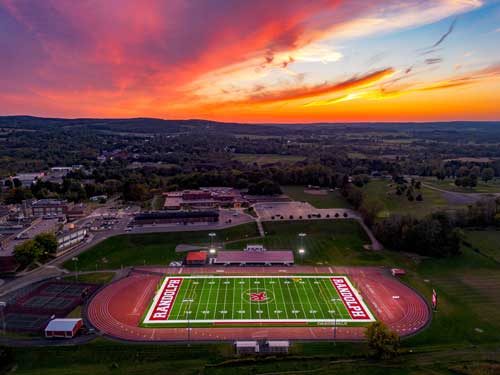
When it comes to watering, Holm said the ballfields have in-ground, automatic irrigation. He added that a goal of theirs is to “use the least amount of water possible to achieve our desired results. We are consistently looking at new technologies to help us achieve this goal.”
Dan Farnes is also on the SFMA board as the professional facilities director. He’s director of fields and grounds for Real Salt Lake, a professional soccer team in Salt Lake City. He and his team manage two facilities with 10 professional sports fields that host many different sports and events. Their stadium holds 20,000 spectators. All the natural turf fields are Kentucky bluegrass, which Farnes said performs well in Utah. “It’s meant to hold up in those high temps we see and can hold up in our colder months as well. It also comes out of dormancy quickly in the spring when our games start in March.”
He said weather is a big challenge, and in early spring and late fall there are freezing temps with snow possibilities. “If there’s snow in the forecast for a gameday, we have to write up a snow removal protocol, which includes when we’ll have snow removed from the field before kickoff and what our plan is to shovel the lines during the game. During the heat of the summer we have to water at night when the temps cool down and make sure we don’t overwater.” Soil sensors in the stadium give temperature and moisture readings, and “we have a couple grow lights that we can put out when it gets cold on worn areas like goal mouths and ref runs.”
The stadium and one other field are sand-based. “They tend to hold up better to wear, have better drainage, are more level and give the teams a premium ball roll,” said Farnes. “We do have to water them more than native fields and they perform better with a more rigorous fertilization protocol. They also need more aeration, topdressing, sweeping, and rolling.”
Farnes said synthetic fields are nice to have indoors and theirs are used almost daily. “The players and coaches don’t like playing on those surfaces because they see more injuries and the ball doesn’t move like it does on natural grass. We still have to groom those fields, repair any tears and fill in low spots with crumb rubber when needed.”
In 2019, Arkansas University removed the artificial turf at Razorback Stadium, where they play football, and replaced it with Tahoma 31 natural grass. Douglas Bradley has been director of sports turf operations at the school since 2023. He said the natural turf is performing great, explaining that they have a stabilized backing grown into it. “I’ve been in this industry for 35 years and watched bermuda just explode as far as the hybrids; Tahoma right now is the best bermuda I’ve ever grown.”
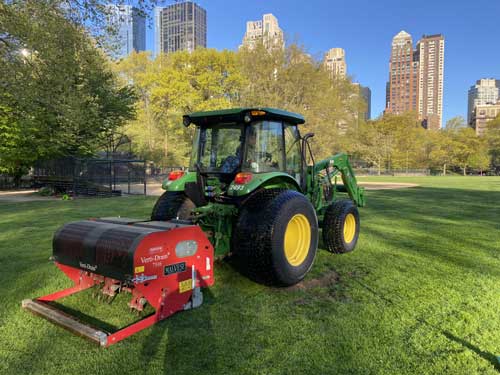
He said they overseed with rye, usually in early October, “but this Tahoma and this system we’ve got with the stability that was grown in, it doesn’t chunk, it gets wear but we’ve had absolutely no footing problems, no repairs, nothing. We go out and mow after the game, and it looks like it’s ready to go again.”
Bradley said with the sand-based fields, they worry less about rain. “It’s going to be wet, but these fields that are built now with pure sand, they can take 10 to 12 inches an hour of rain.”
He said their women’s soccer stadium was also recently rebuilt, and is now a sand-based spec field with Tahoma 31. He described being in the Super Regionals one weekend, and playing two games on Friday. Then rains came, and Sunday’s game was played in a torrential downpour. “Watching the ladies, it was the same as playing if it had been 60 degrees and sunny. We never had an issue when they were done, you couldn’t even tell they’d been on it.”
Synthetic Delivers Solutions
Bradley was previously turf manager for the Cincinnati Bengals. Their main stadium was natural turf but has since converted to synthetic. Half of NFL stadiums are synthetic turf. One outdoor field at Arkansas is synthetic, used regularly for training because of the number of athletes. “They’ll use it a little bit more if we’re going to play a team that week that has synthetic, just to give players a little bit better feel.” There are also a couple indoor synthetic fields used for baseball and other training.
Rick Krysztof is vice president of sales for a Williamsville, N.Y.-based manufacturer of artificial turf. He said high school applications are the largest users of artificial turf nationally, with colleges and universities right behind. “There’s been a recent push toward baseball and softball turf applications because they’re much easier to maintain and allow for all-day playability in addition to getting an earlier start to the season, especially in the northeast where weather conditions create havoc for grounds crews trying to prepare natural fields for play.”
Parks and rec departments are also installing an increased number of artificial fields in recent years, according to Krysztof, due to the high demand for rec leagues and youth athletic programs. “There’s a higher upfront cost to install artificial turf, but when you factor in increasing the usage almost five times in most situations (due to weather), your cost per event is much lower on an artificial turf field.”
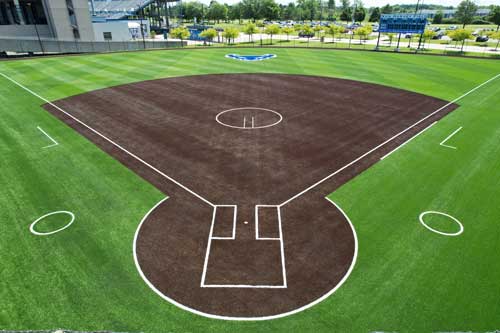
Krysztof explained that the turf is only as good as the base and drainage system it’s installed over, and systems need to be well-designed and tested every step of the way. “For example, proper pitch, grading, elevations, stormwater drainage, compaction requirements, depth and quality of stone, perimeter edging, equipment footings, and fine grading to achieve ideal planarity are achieved before installing the turf system.”
In addition to determining the proper turf face weight your field requires, primary and secondary backings are also critical, according to Krysztof. “A good turf system primary backing provides great cross-dimensional stability, which equates to straighter lines and less stretching/wrinkling of the turf over time.” The urethane secondary coating impacts how well the material seams together in addition to optimizing “tuft bind,” which is related to individual fibers being pulled out over time from play, maintenance, and other activities. “Ideally you want to have a tuft bind of 10 pounds of force or better.”
As far as synthetic turf infill, the majority of fields use SBR crumb rubber—recycled tires—according to Krysztof, due to its performance, safety, and durability for the price. “Other systems include EDPM rubber, coated sand, and other organic materials,” including cork, coconut husks, and peat moss. He said price, cooling properties, specific performance requirements, and environmental concerns “may lead to selecting a certain infill system.
“Routine maintenance includes grooming a field once a month with the turf provider’s recommended maintenance equipment, checking inlaid lines, and replenishing infill in hotspot areas like lacrosse creases, corner kicks, batter’s boxes, and other heavy-use areas,” continued Krysztof. “You want to make sure you assess and maintain infill levels as fields age, and deep clean and de-compact a field and run a magnet to pick up any metals.”
Canisius University, a private school in Buffalo, N.Y., competes in NCAA Division One athletics at Demske Sports Complex, recognized as a model for urban college campuses. In 2022 the old synthetic field was replaced with a new one. Bill Maher, director of athletics at the school, said it’s a similar system, featuring “…longer turf strands with crumb rubber infill. Our previous field lasted 13 seasons, so the durability of the design and the installation were well done. We also removed the warning track surface and installed turf to the curb line, which was a very helpful upgrade to the look and durability of that space.”
Baseball, softball, and men’s and women’s soccer and lacrosse are played on the field. “Our club and intramural teams use the space as well,” said Maher. “We also host high school championship events as well as summer camps and tournaments. The usage our field gets and the weather are the biggest factors that determined synthetic turf. Natural grass wouldn’t have been a possibility with the usage level and snow removal required. We’re on the field from mid-January to November.” He said most schools in their region use synthetic turf.
“We groom the field with a small rake that’s pulled behind a tractor every two weeks,” said Maher. “The athletes love it. The colors pop, and the logos make them feel terrific, and the coaches and athletes all remark that the new surface is much softer than the previous one.”
Technology & Sustainability
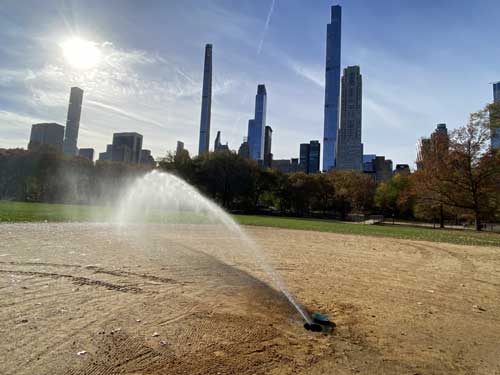
As far as newer technologies, “Probably the biggest push right now is the automated paint machines, where you can paint fields with the robot,” said Bradley. “You start to see that in other aspects of the green industry, robot mowers and things.”
He said another big push is grow lights. “The demand has been there a long time, and the industry is catching up with that. There are some really good systems that are easy to maneuver and work with and handle. They do what they’re advertised to do, and they do help grass in shaded areas and that have a cooler temperature.”
Back in Central Park, Holm said they’re taking advantage of some technologies on the irrigation front, including getting all of their in-ground irrigation on the cloud to be remotely managed. “We’ve installed in-ground soil moisture meters to help make more informed decisions, and we’ll look to install more in the future.”
He said that in 2024 they had some satellite imagery taken to help evaluate plant health. “The findings were really interesting, but I’m not sure the technology is really there yet; it’s something we’ll continue to try and work with to be on the forefront. In 2025 we’re looking into additional technologies such as mower-mounted moisture sensors.”
During Holm’s time with the Red Bulls, their arena and training facility both won the SFMA Professional Soccer Field of the Year award twice. Both facilities were among some of the first to be certified by SFMA for environmentally responsible management, which Holm said got him interested in serving on the SFMA environmental committee. “I’m passionate about it because I think our industry gets unwarranted negative connotations regarding the environment.” And while what they do in Central Park is different from what they did at the Red Bulls facility, “at the end of the day in both situations it’s using the least amount of inputs needed to produce safe, playable, and aesthetically pleasing fields and lawns.”
Staff Challenges
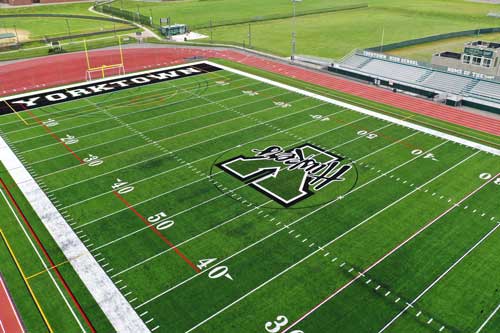
Many in the industry recognize that it’s getting more difficult to fill positions, and more needs to be done to attract young people. Some strategies include increasing diversity in the industry, improving salaries and work/life balance, and bringing turf professionals into classrooms.
“I’ve long thought that the sports field industry should be recruiting in high school athletic programs,” said Holm, who holds a bachelor’s degree in turfgrass management. “The interest in playing sports is what drew so many of us into the industry so that we would continue to be in sports, and we should tell that story to kids who have a love of sports.”
Bradley echoed the challenges of finding good people. He mentioned some university turf programs that have shrunk or ceased altogether, but said that professors he’s talked to at Arkansas have lately seen interest rebound a bit. “A lot of the younger guys who get into it don’t realize the kinds of hours involved; you have to really have a passion to do this.”
Farnes pointed out that “There are a lot more online classes people can take to get turf certificates at University of Georgia, Oregon State, and the SFMA website has started to offer classes as well. Local golf courses and municipalities are always hiring, and those jobs can lead you into professional sports turf management if you want to go that direction.”
Holm, who is president of the Sports Field Managers Association of New Jersey, thinks that both the national and local SFMAs are great resources for field managers. “One of the coolest things about our industry is there are so many unique facilities and unique management of those facilities. There is always something to learn from each other, and SFMA is the conduit to be able to do that.”
Added Farnes, “I’ve met so many great people who have taught me a lot. It’s those relationships that I can rely on to help me with any issues that might come up or to just have a chat with friends in the industry.” RM

